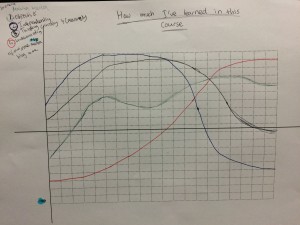My Learning Graph
How much I’ve learned in this course…

- Green– How much is learnt about making media objects/stories
- Blue– Ability to work independently in unfamiliar ways/systems/new tools
- Black- Thinking critically and creatively
- Red– Understanding of the role media blog to me
The Top 5
Way Back to the Monroe Time
What is Editing
Listen To Me!
Genre(mixes)
The Satirical New & Old iPhone
Final Reflection So Far
Here I am posting this last blog this semester. Wow! This semester went so fast as in a blink of an eye. I have learned so much, ominously, especially having a little knowledge in media production. I have taken media courses in high school, but definitely not one of the best students in class. However, being able to choose breadth or different courses relating to our own interest has motivated me significantly throughout the semester.
Learning broader and deeper concepts in Cinema Studies course has developed my previous knowledge about the world of cinema. Watching The Wizard of Oz, experimental films like Koyaanisqatsi, or even learning mise-en-scene and shot aspects might be a little repetitive. But having discovered great films and filmic terms that I’ve never heard before has been one of the most things I’m interested in. Hence, my passion in the cinema world. Media, being a 24-point course started off nice and easy. As experimental and abstract style has been my primary interest in filmmaking, I decided to base by first two project briefs with an ambiguous sense of content and was quite happy with my brief #3. Despite that I was already getting a hang of editing in iMovie, producing these two short films has made me learn heaps amount of techniques as well as being inspired by what was obtained from Cinema Studies. And when I think of it (having a light-bulb moment here), all these courses I’ve done are all connected. Last of but not least, Popular Culture explores substantial amount of ideas about social networking, music videos or films that are relevant to the Media and Cinema Studies. Plus, I’ve undergone at least one group work in each of the courses while annotated bibliography appeared in two of these courses. Seems to me that Media & Communication is like a spider web, each strand having similar characteristics yet in different placements.
Being a mostly hyper-attentive learner, I don’t learn well in silence or should I say “less noises”. I watch and observe, communicate to get ideas and need some breaks once in a while. During the semester, getting ideas presented in my projects required me to go out and explore the world while collecting inspirations. As Rachel had mentioned in our Lectorials it is important to “notice” what’s surrounding us, I noticed that our break is coming real soon and very excited to “ideas-shopping” for the next coming semester.
What were the most challenging aspects of this course? I found that getting out there and present my work (and myself) to the crowd is nerve-wrecking. Confidence had been the challenge in every presentation that I did even when I’ve somehow overcome it previously. But throughout all the courses in this semester, having done video logs, group presentations and individual film performances had helped an improvement on my courage.
I’m sure that we’ve all done this somewhat regularly in producing a media artefact. Sometime we have started off blank and have no idea whatsoever, not even really know how to use a movie editing software. It surprises me though, that of all those “light-bulb” moments of creativity came mostly accidental. I’ve always wondered how a split screen is complemented and yet, discovered that vertical split screen can have an overlapped shots horizontal with a vertical shot (as complemented in Brief #3). Therefore, creativity not only comes from inspirations and a remix of those ideas but also accidents in experimental techniques.





